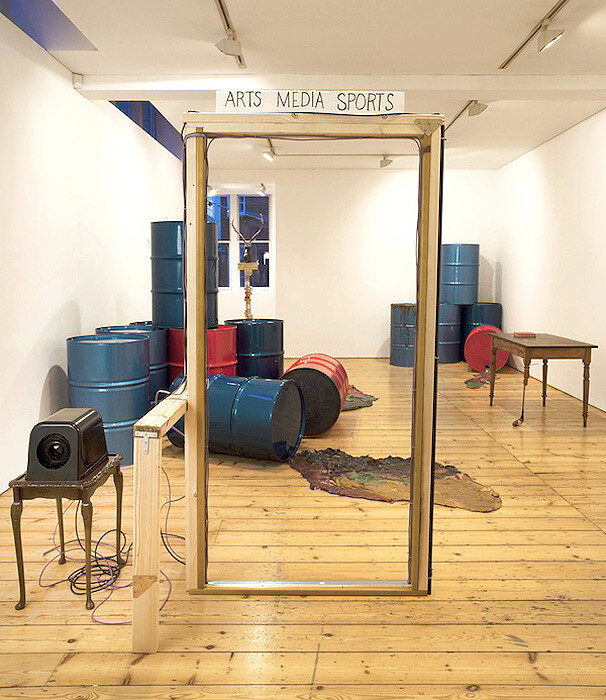One enters the modest exhibition space of Sprovieri through what looks like a homemade security gate. The title of the show, “Arts, Media, and Sports,” hails from atop of this eponymous work, throwing visitors into a realm of Durhamian logic. What do these three realms—art, media, and sport—have in common, and what connects the title to the objects in the show? The show is dominated by two groups of colorful oil drums, Spring Fever (all works 2010) and Crude Oil, with multi-colored spills emanating from them. Another reoccurring motif in the show is the golf club, an object that appears in three sculptures, After ‘The Prize of the Silver Golf’, Second Life, and Some Of These People Are Dead.
The components of this exhibition form a matrix of meanings within the framework of Durham’s concerns, but there’s a sense that something is missing for it to come together as a whole. (Like the marriage of divisions in the British government’s Department for Culture, Media, and Sport.) To be fair, the works in this show were originally created for the Tatton Park Biennial (2010), and Durham’s solo show at the Glasgow Sculpture Studios (April 2010) called “Universal Miniature Golf (The Promised Land).” The parenthetical “Promised Land” is crucial within this context, since it forms the connection between oil and golf. Both represent commercial interests that continue to supersede the basic land rights of American Indian peoples in the US and Canada. Two important text pieces in the Glasgow Sculpture Studios exhibition missing from this show explain this context both in terms of exhibition narration and formal relations. Joe David Screen is a sculpture consisting of text written on an old portable projection screen with the story of Joe David, a Mohawk artist killed by Canadian police at his home whilst protesting the government decision to build a nine-hole golf course on sacred Mohawk burial grounds. The other missing work, A Scottish Conspiracy, consists of two pieces of rough paper: a series of portraits and Durham’s text, recounting the Indian Wars of the 19th century as “Except for a bunch of dead Indians it was like Scots fighting Scots.” That is, some Scots had inter-married with several tribes on the Indian side—even taking over the chieftain positions—while others held positions of great responsibility on the U.S. side. With these two works in mind, the work After ‘The Prize of the Silver Golf’ makes an important connection between Scotland and golf within the narrative of this series of works. The original work ‘The Prize of the Silver Golf’ was painted in 1780 by the artist David Allan who was best known for his traditional Scottish subject matter, and golf is a traditionally Scottish game. The golf clubs that appear in this work and others not only represent a recent incursion onto American Indian land, but also an ongoing historical incursion into American Indian culture as a whole.
An understated but important work in the show is Shirt Poem, consisting of text written on a cotton shirt. Shirt Poem brings the show’s ideas together in an ostensibly low-key and rambling stream of consciousness on the relationship between media and the intercontinental trade of material goods and culture from ancient times to the present day. Here, the core meaning of “media” as a carrier of a message sheds light on the nature of the colorful liquid oozing from the oil drums: “We should always imagine, I think, that the artist’s intentions are not the entire story. Once material becomes saturated with social meanings there must be much over-spill and inadvertent confession.”
Jimmie Durham does not like the idea of “instructional art”—art with a clear motive or purpose. However, the saturation of social and historical meanings of making work in Scotland, a country overflowing with historical relevance to Durham’s concerns, perhaps caused an inadvertent confession of the artist. Durham’s attitude of being “Against Architecture,” “Against Narration,” and “Against Structure” here separates his work from contemporaries such as Anselm Kiefer whose historical subject matter and formal material are bound together. In “Arts, Media, and Sports” Durham’s humor and formal lightness of touch ensures each work’s autonomy from their heavier narratives.






